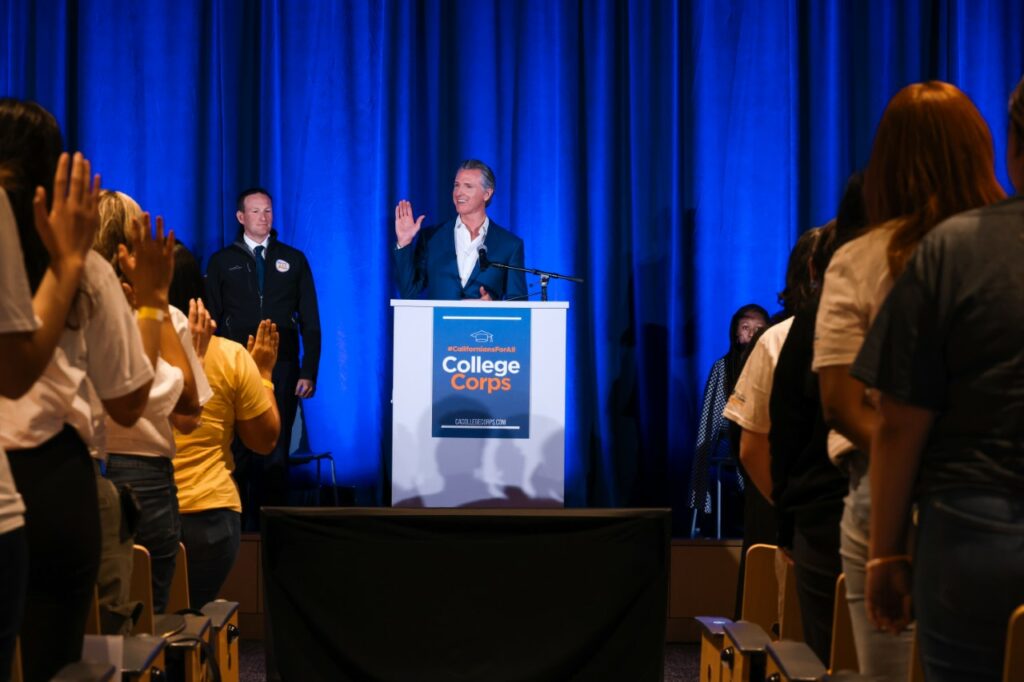
2024 Student Voices Arts Advocacy Day at Cal Arts
Credit: Las Fotos Photography
Middle school students eagerly swiping paintbrushes across canvases, a group of fifth graders rehearsing lines from their upcoming play, and a first-time high school cello player thrilled to be part of the orchestra — all beaming with confidence, excited to attend school, and developing critical life and career skills.
These are scenes that California voters, who overwhelmingly passed Proposition 28 in 2022, expect in every school. Ensuring every student benefits from the power of the arts is why I joined Create CA, the arts education advocacy organization, as executive director six months ago. I firmly believe, and research has shown, that the arts are critical for a well-rounded education and student success.
Unfortunately, student access to the arts is inequitable and often depends on the unpredictability of local fundraising, community advocacy and school districts prioritizing the arts. Voters passed Proposition 28 to address these challenges.
The promise of Proposition 28 is increased access to the arts for all California public school students by providing dedicated, ongoing funding to expand the number of arts education teachers. Regrettably, we’ve heard that some districts are not complying with the law and the voters’ mandate to use the new funds to supplement (i.e., expand), not supplant (i.e., replace), their existing arts education funding.
Californians voted for more arts education for all students, not the status quo. Create CA has been in touch with school leaders, teachers, parents and students who have shared examples of success, which we celebrate. In contrast, others have disclosed suspected violations in their respective school districts.
Districts meeting the promise of Proposition 28 have several things in common: a dedicated district arts education coordinator, an arts education strategic plan developed with community input, and a Proposition 28 report (mandated by the law) that clearly describes how their school district used the new funds to expand arts education. A great example is San Gabriel Unified, which outlines in its Proposition 28 report the hiring of two new art teachers, more dance and theater instruction at its elementary schools, and other investments that further its arts strategic plan.
Another exemplary model is the Long Beach Unified School District (LBUSD). The district formed a committee and implemented a plan that included creating job descriptions, arts curriculum planning, coaching and a Proposition 28 communication strategy. The result is that Long Beach hired itinerant teachers from all arts disciplines across its 35 elementary schools and added nine middle school positions and six high school positions. Because of these measures, every student will have access to the arts from K-12th grades, as the proposition intended.
On the other hand, some communities suspect their districts are willfully violating Proposition 28’s intention. Parents, unions and the author of the proposition are suing the Los Angeles Unified School District (LAUSD) for eliminating existing funding for the arts and replacing it with Proposition 28 funds. We’ve spoken with teachers at Chula Vista Elementary School District who allege that the district intended to fire arts education teachers with the plan of rehiring them with Proposition 28 funds, skirting the law’s intention. In Hayward Unified, one teacher noted that “5.8 positions currently funded from Proposition 28 are being cut.” One of Create CA’s student advocates wrote a story on South Pasadena Unified’s plan to move funding for their elementary visual arts and music teachers from a “temporary funding source to this Prop 28 restricted permanent resource.” These examples demonstrate that school districts statewide may be denying students the right to more arts education as voters demanded.
We know schools face multiple challenges, but students deserve better. Arts education can help schools meet many of their challenges and help save money by reducing dropout rates, increasing attendance, attracting more community support and improving academics and mental health. All school districts should follow the law of Proposition 28 to ensure all their students have access to all the arts, all year. It’s every student’s right.
•••
Veronica Alvarez, EdD, is Executive director of Create CA, a nonprofit that advocates for high quality arts education for all students.
The opinions expressed in this commentary represent those of the author. EdSource welcomes commentaries representing diverse points of view. If you would like to submit a commentary, please review our guidelines and contact us.




